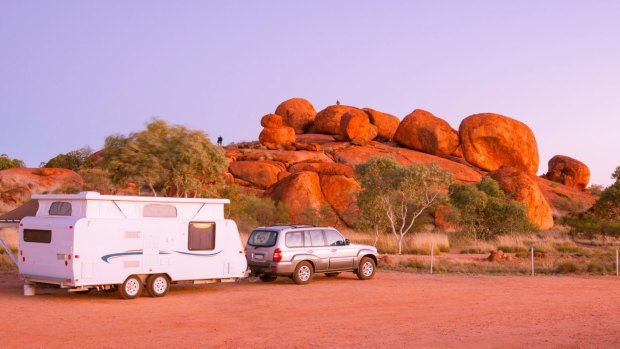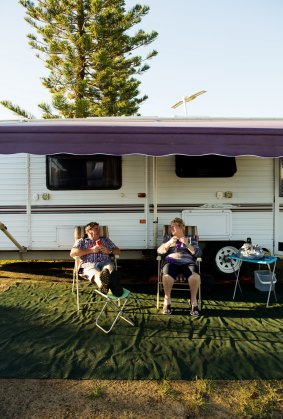This was published 2 years ago
Tips on buying and driving with a caravan: Sales boom as Australians hit the road
By Catherine Best

Caravan sales are booming as Australians look to explore their own country in 2021.Credit: Alamy
Forget home office desks and loo roll – they're so last year. This is the year of the caravan. With domestic travel sputtering back to life within our antipodean moat, caravans have become hot property.
Sales are up – as much as 242 per cent, according to the Zip Weekly Spending Index – and waiting times for new caravans have blown out by up to a year.
The second-hand market has gone gangbusters, too. Caravans listed on caravancampingsales.com.au sold almost twice as fast in December 2020 compared with 2019.

Gary and Karen Kennedy from Shepparton, Victoria, make an annual migration with their caravan to Queensland for winter.Credit: Elise Derwin
"There's certainly a shortfall in new caravans at the moment, with waiting lists at many caravan manufacturers pushed out to nine to 12 months," says caravancampingsales RV editor Chris Fincham.
Growing demand, coupled with forced lockdown closures in Melbourne, where most Australian caravans are manufactured, is expected to push up prices across the board, he says.
At Jayco, Australia's largest caravan manufacturer, production has ramped up by 35 per cent, with 13,800 caravans, camper trailers and motorhomes set to roll off the production line this year. Nationally, more than 20,000 recreational vehicles (RVs) are manufactured in Australia each year, and that figure is rising.
"Caravans have been growing in popularity in recent years … but it seems to have reached new heights since COVID-19 travel restrictions took effect, with many Aussies now opting to buy a caravan for the first time and holiday locally after the cancellation of international trips and cruises," Fincham says.
Caravan Industry Association of Australia spokesman Keelan Howard says the pandemic has tapped into a new market of caravanners keen to enjoy the camping lifestyle with the "unmatched safety benefits" of self-contained kitchen and bathroom facilities. "Caravans as a product group remain the most in demand (of RVs)," he says.
If you want to join the caravan of caravans, you need to do your homework. Buying a new home on wheels is a $50,000-plus investment that requires a crash course (excuse the pun) in RV linguistics and towing arithmetic.
Here's everything you need to know.
The right RV
Big or pint-sized, off-road or touring, conventional or pop-top? There are so many caravan options. While the decision often boils down to budget, it also depends on the kind of caravanner you want to be. Empty nesters travelling light and sticking to sealed roads and van parks? A small base-model will do. Packing in a family? You'll need to add a foot or two for every child. Going off road? You want something robust, self-contained and typically higher end with independent suspension and good clearance – not to mention solar panels, a battery system and inverter – if you want to do it in style.
A weighty issue
The size of the caravan you buy is ultimately determined by the weight and towing capacity of your vehicle (or vice versa if you're in the egg-before-chicken camp). It's crucial you understand your vehicle and caravan weight capacities. Your safety depends on it.
In a nutshell, you need to know how to crunch the acronyms. First there's the GVM (gross vehicle mass) – that's your car's maximum weight capacity. Then there's the ATM (aggregate trailer mass), which is the van's weight limit. Put them together and you get your GCM (gross combination mass), which is the maximum legal weight specified by the vehicle manufacturer. You also have to be mindful of the TBM (tow ball mass), which redistributes some of the caravan's front-end weight to the vehicle.
Pack smart
To further complicate matters, what you pack and where can have a big impact on weight distribution and towing performance. Your caravan's ATM comprises the tare (it's net weight at manufacture), plus the payload made up of the items you carry, including water, food, clothes and however many gadgets you fancy. Heavy items should be packed low and concentrated over the axles. Too much weight at the rear and the caravan can fishtail, too much up front and you risk exceeding the TBM and putting stress on your vehicle. Too much weight overall and you are driving illegally and your insurance could be void.
Tow safe
How to tow a three-tonne house isn't part of the driver licensing process, so if you want to save your investment from becoming landfill on an outback highway, a towing course is recommended. Tow-Ed training courses teach drivers how to hitch up, manoeuvre safely on the road and reverse park. They may even save your marriage.
"The main objective of the course is learning to be a better driver who is fully aware of the size and manoeuvring techniques of towing," says Tow-Ed director Julie Eggenhuizen. "Caravans are getting bigger and heavier so understanding how they react on the road and reversing is also vital." See tow-ed.com.au
Caravan crush
It's the in thing to #holidayherethisyear, so you'd better get booking. While there's a certain romance to freewheeling, popular travel destinations book out fast during peak season – Broome is notorious in the dry, and that's pre-pandemic. For less-crowded, off-the-beaten-track stays, try free and low-cost campsites on sites like WikiCamps (wikicamps.com.au) and HipCamp (hipcamp.com).
Sign up for the Traveller newsletter
The latest travel news, tips and inspiration delivered to your inbox. Sign up now.